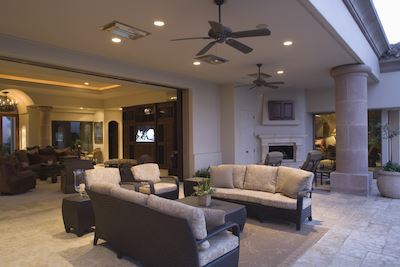Love your outside living space but rarely use it because of the heat? Maybe it’s time to install a ceiling fan.
But not every ceiling fan will do. There is a difference between indoor and outdoor ceiling fans. Outdoor fans offer damp and wet ratings that allow them to operate in all kinds of weather conditions, including humidity and rain. Selecting the right one can help you enjoy your patio, pergola, or gazebo a little bit more.
 Where can you use an outdoor ceiling fan?
Where can you use an outdoor ceiling fan?
The good news is you can install one just about anywhere. Ceiling fans are not only functional, but they are decorative too. They can add ambiance even when they aren’t in use.
Install them in an outdoor porch. The air movement will make it the perfect place to sit and read a book on a lazy day.
Install them in a sunroom. These are some of the most popular places we install them. Sunrooms are beautiful additions for offices, home, or even restaurant space. But with the sun glaring down, the heat and humidity can quickly build. A stream of fresh air from a quiet ceiling fan can be the perfect addition to make your space more functional.
Install them in a garage. Garage space is often the hottest in the home. A ceiling fan can move the heat often trapped up towards the roof. If you work in the garage for any length of time, a ceiling fan is a must.
What’s the difference between indoor and outdoor ceiling fans?
An outdoor ceiling fan has several things that make them safe for outdoor use.
The blades are made with a special ABS plastic that makes them safe for use in all kinds of weather.
The fans are manufactured using galvanized steel and powder-coated paint to stop corrosion and rust.
And most importantly, the motor casing is waterproofed and can withstand moisture up to its rating value.
The good news is that just like indoor ceiling fans, their outdoor counterparts come in many different sizes and styles. You should select the size based on the square footage of the space you are trying to cool. Small spaces can get by with a small 29 inch ceiling fan, while a larger space may do better with one up to 54 inches in width. Styles can range anywhere from traditional to contemporary, to industrial with their metallic blades.
What look is right for you in outdoor ceiling fans?

